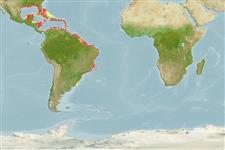Environment: milieu / climate zone / depth range / distribution range
Ecologia
marino; acqua dolce; salmastro demersale; amfidromo (Ref. 46888). Tropical; 25°C - 30°C (Ref. 97140); 32°N -
Northwest to western Central Atlantic: Bermuda, Bahamas, South Carolina and northern Gulf of Mexico in USA to southeastern Brazil.
Size / Peso / Age
Maturity: Lm ? range ? - ? cm
Max length : 25.0 cm TL maschio/sesso non determinato; (Ref. 7251); common length : 12.5 cm TL maschio/sesso non determinato; (Ref. 12193)
Spine dorsali (totale): 7; Raggi dorsali molli (totale): 9; Spine anali 0; Raggi anali molli: 9
Adults are found on shallow, muddy or sandy bottoms (Ref. 13628). They appear to prefer estuarine freshwater tributaries, occurring in waters with a salinity range of 0 to 19 ppt (Ref. 7251), or up to 36.6 in some cases (Ref. 97140). Feed on dipteran larvae and pupae (especially the juveniles); crustaceans like crabs and shrimps; and small fishes. The diet changes with sexual maturity and season. Gonadal development takes place during the dry season. Average size at maturity is 5.7 mm for males and 4.3 mm for females (Ref. 35237).
Life cycle and mating behavior
Maturità | Riproduzione | Deposizione | Uova | Fecundity | Larve
Robins, C.R. and G.C. Ray, 1986. A field guide to Atlantic coast fishes of North America. Houghton Mifflin Company, Boston, U.S.A. 354 p. (Ref. 7251)
IUCN Red List Status (Ref. 130435)
Threat to humans
Harmless
Human uses
Informazioni ulteriori
CollaboratoriImmaginiStamps, Coins Misc.SuoniCiguateraVelocitàModalità di nuotoArea branchialeOtolithsCervelliVista
Strumenti
Special reports
Download XML
Fonti Internet
Estimates based on models
Preferred temperature (Ref.
123201): 23.4 - 28.1, mean 27.2 °C (based on 808 cells).
Phylogenetic diversity index (Ref.
82804): PD
50 = 0.5000 [Uniqueness, from 0.5 = low to 2.0 = high].
Trophic level (Ref.
69278): 3.7 ±0.4 se; based on diet studies.
Resilienza (Ref.
120179): Medio, tempo minimo di raddoppiamento della popolazione 1.4 - 4.4 anni (Preliminary K or Fecundity.).
Fishing Vulnerability (Ref.
59153): Low vulnerability (15 of 100).
